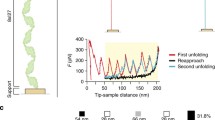Abstract.
Proteins of thermophilic organisms are adapted to remain well structured and functional at elevated temperatures. Nevertheless like their 'cousins' that reside at medium temperatures, they require the assistance of molecular chaperones to fold properly and prevent aggregation. This review compares structural and functional properties of the DnaK/ClpB systems of Thermus thermophilus and, mainly, Escherichia coli (DnakTth and DnakEco). Many elemental properties of these systems remain conserved. However, in addition to a general increase of the thermal stability of its components, the DnakTth system shows profound differences in its regulation, and genetic as well as oligomeric organization. Whether these differences are unique or represent general strategies of adaptation to life at elevated temperatures remains to be clarified.
Similar content being viewed by others
Author information
Authors and Affiliations
Additional information
RID="*"
ID="*"Corresponding author.
Rights and permissions
About this article
Cite this article
Schlee, S., Reinstein, J. The DnaK/ClpB chaperone system from Thermus thermophilus . CMLS, Cell. Mol. Life Sci. 59, 1598–1606 (2002). https://doi.org/10.1007/PL00012486
Issue Date:
DOI: https://doi.org/10.1007/PL00012486




